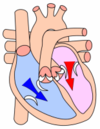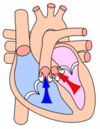Systole
|
|
Systole is the contraction of the chambers of the heart, driving blood out of the chambers. The chamber most often discussed is the left ventricle. However, all four chambers of the heart undergo systole and diastole in a timed fashion so that blood is propelled forward through the cardiovascular system.
Electrical systole is the electrical activity that stimulates the myocardium of the chambers of the heart to make them contract. This is soon followed by Mechanical systole, which is the mechanical contraction of the heart.
Atrial systole is the contraction of the myocardium of the left and right atria. Electrical systole of the atrias begins with the onset of the P wave on the EKG.
Atrial systole, which normally occurs in the late portion of ventricular diastole, causes increased pressure in the atrium and added blood flow into the ventricles. This added blood flow is known as atrial kick, and is absent if there is loss of normal electrical conduction in the heart, such as during atrial fibrillation, atrial flutter, and complete heart block.
Ventricular systole is the contraction of the myocardium of the left and right ventricles. Electrical systole of the ventricles begins at the beginning of the QRS complex on the EKG.
At the beginning of ventricular systole, the pressure in the left ventricle increases. This soon eclipses the pressure in the left atrium, closing the mitral valve. The pressure in the left ventricle continues to rise, until the pressure in the ventricle is greater than the pressure in the aorta. This causes the aortic valve to open, allowing the blood to eject into the aorta, to perfuse the end organs of the body.
Other meanings of the word Systole:
- A term in mathematics used in Riemannian geometry, see Glossary of Riemannian and metric geometry.


